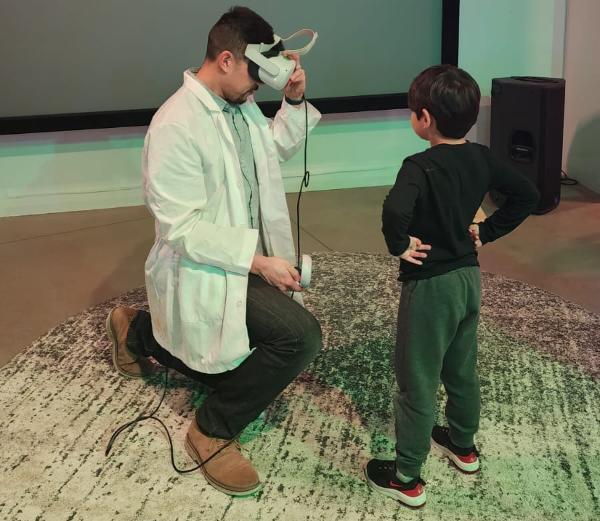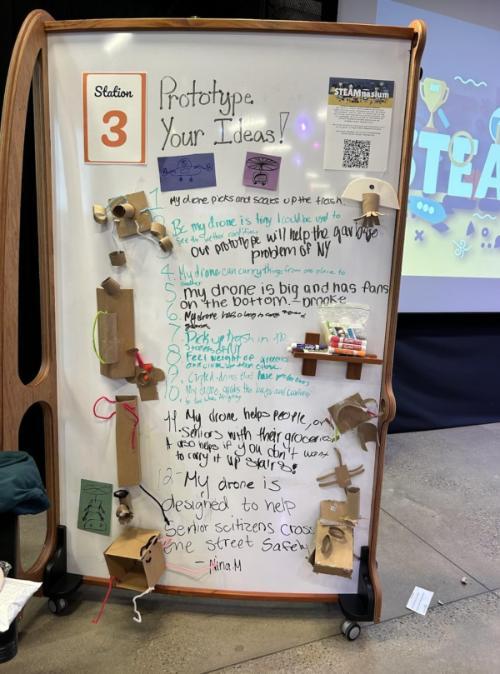by Yvonne Thevenot
The 2023 STEAMnasium, produced by the Math, Science, and Technology department, was held at Teachers College, Columbia University from 10:00 am to 2:00 pm at the Smith Learning Theater on March 8. The Center for Technology and School Change (CTSC) featured a series of STEAM activities for PreK-12 learners that were centered on exposing participants to robotics, drone technology, and makerspace innovation and design in culturally relevant and responsive ways. One of the stations involved utilizing inquiry-based and play-based learning in a series of robotics activities that enabled learners to use coding blocks with iPads to build their skills in computer science and computational thinking that was centered on a student’s cultural assets. Students engaged with CTSC staff to complete exercises that enabled them to explore different cultures through food, while they used robotics to bring the food market to life. Another engaging exercise allowed students to connect their own lived experiences to technology, and encouraged students to program, using block coding, the robot to explore and interact with a neighborhood scene from their own life that they created with art and repurposed materials.
In addition to being centered in culturally relevant and responsive frameworks, the robotics station enabled learners to utilize their skills in sequencing, tinkering, and logic to program the robots in self-directed play scenarios that resulted in the robots completing tasks programmed by the brilliant learners. A series of uniquely designed programs were generated by learners from ages 4-14, who shared their solutions they created to program the robots to perform certain tasks. For those PreK learners, it was fun sitting beside them and listening to them explain how they could influence the movements of their robot by= using the iPad, or through voice commands. For the youngest learners, we provided a robotic driving program on the tablet that did not require coding and allowed them to problem-solve as they navigated robots around obstacles they placed around the floor.
For teachers who stopped by, we provided transdisciplinary design plan examples so that they could inquire about the transdisciplinary project-based learning unit construction, and how to build in room to consider the values, traditions, and customs that comprise the surrounding community, helping teachers and students to understand better the problems and challenges faced by neighbors and members of the community at large.

The second station that the CTSC managed showed a film that encouraged teachers and participating adults to think deeply on how project design plans reveal meaningful and relevant learning activities that involve technologies such as robots and drones in K-12 classrooms. The film showed teachers in a district north of New York City, in a grant focused on technology integration, who were guided toward culturally responsive teaching and design through real-world application for their students. Although the video loop of teachers and drones at STEAMnasium did not specifically communicate the process that led to using drones with students, it served the purpose of getting teachers to stop and ask questions.
This station also offered a hands-on activity for students to deepen their learning. In the unit implementation, space was made for the lived experiences of all students to be heard as they brainstormed the identification of problems that the drones could help with. What we know to be true is that when you make room for diverse perspectives and the variety of lived experiences to be included in learning spaces - even learning spaces without walls, as was the case in STEAMnasium - students bring into the learning space what makes for a more inclusive and meaningful learning experience. By valuing and incorporating the unique perspectives and experiences of each student, the classroom becomes a more welcoming and supportive environment where all students feel seen, heard, and valued. This can help build trust between students and teachers and foster a sense of community within the classroom. Although the use of drones was exciting, what the teachers saw, in addition to high levels of engagement, were students taking ownership of their learning and engaging more deeply with the content, ultimately leading to more successful outcomes for all students.
The third station managed by CTSC was a drone prototyping station that allowed students to address a challenge and then innovate a drone using makerspace materials. Students had a choice of 3 challenges to select: choice 1 called for students to innovate a drone prototype that supported individuals to move their groceries upstairs to an apartment, choice 2 called for students to innovate a drone prototype that helped a senior citizen in their community, and choice 3 called for students to innovate a drone prototype that solved a problem the students thought of. At the station, students had a variety of supplies to select to innovate their prototype. They were first instructed to draw their design, then use the materials to create the 2D or 3D prototype. No one prototype looked like the other and a refreshing finding was that no drone prototypes resembled what a drone of today looks like. We made room for students to take risks and think out of the box, guided them to think beyond what they know of the common design of a drone, and encouraged them to explore new and innovative design options that would support their selected challenge and design.
With the use of innovative, culturally relevant and responsive frameworks that support students in developing their conceptual knowledge, as well as integrating students’ lived experiences and cultural assets into the learning space, CTSC practices teaching methods that focus students on authentic and rigorous project-based learning while honoring individual learning styles. We’re proud to partner with schools and school districts, administrators, teachers, and students around the world in order to support the development of learning environments that integrate project-based learning, inquiry-based learning, and culturally relevant and responsive teaching frameworks that are inclusive and support all students to succeed in the complex world we live in.
